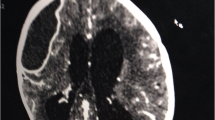Abstract
Backgroud
Pediatric brain abscesses usually occur as a consequence of predisposing conditions, such as ENT (ear, nose, and throat) infection and physical damage. But there are still a number of cryptogenic infection cases.
Methods
We present an unusual cryptogenic infection case of multiple and multiloculated brain abscess in an infant, which was in the absence of ENT infection, meningitis, trauma, prior surgery, cyanotic heart disease, or immune defect. The child has no specific symptoms but keeping apathic and days of diarrhea. Deduced from clinical presentation and this case’s DWI-MRI features, the onset of infection is hematogenous route, and the diarrhea could be the possible inducement. The child was successfully treated by surgical excision of big lesions and an 8-week total course of intravenous antibiotics. At the end of the 1-year follow-up period, the infant is well at both of physical and mental health.
Conclusion
The interest of this case is the silent clinical presentation and the possibly rare precipitating factor. To a certain extent, the variation trend of blood C-reactive protein level could predict the clinical effect of antibiotics in brain abscess case.



Similar content being viewed by others
References
Mameli C, Genoni T, Madia C, Doneda C, Penagini F, Zuccotti G (2019) Brain abscess in pediatric age: a review. Childs Nerv Syst 35:1117–1128
Sahbudak Bal Z, Eraslan C, Bolat E, Avcu G, Kultursay N, Ozkinay F, Kurugol Z, Vardar F (2018) Brain abscess in children: a rare but serious infection. Clin Pediatr (Phila) 57:574–579
Brouwer MC, Coutinho JM, van de Beek D (2014) Clinical characteristics and outcome of brain abscess: systematic review and meta-analysis. Neurology 82:806–813
Atiq M, Ahmed US, Allana SS, Chishti KN (2006) Brain abscess in children. Indian J Pediatr 73:401–404
Acar M, Sutcu M, Akturk H, Muradova A, Torun SH, Salman N, Caliskan M, Izgi N, Somer A (2018) Evaluation of short-term neurological outcomes in children with brain abscesses. Turk Neurosurg 28:79–87
Gilard V, Beccaria K, Hartley JC, Blanot S, Marque S, Bourgeois M, Puget S, Thompson D, Zerah M, Tisdall M (2020) Brain abscess in children, a two-centre audit: outcomes and controversies. Arch Dis Child 105:288–291
Shachor-Meyouhas Y, Bar-Joseph G, Guilburd JN, Lorber A, Hadash A, Kassis I (2010) Brain abscess in children - epidemiology, predisposing factors and management in the modern medicine era. Acta Paediatr 99:1163–1167
de Oliveira RS, Pinho VF, Madureira JF, Machado HR (2007) Brain abscess in a neonate: an unusual presentation. Childs Nerv Syst 23:139–142
Tsutsumi S, Arai H, Hishii M, Suzuki K, Sato K (2003) A case of neonatal cerebellar abscess. Childs Nerv Syst 19:683–685
Rossi A, Martinetti C, Morana G, Severino M, Tortora D (2016) Neuroimaging of infectious and inflammatory diseases of the pediatric cerebellum and brainstem. Neuroimaging Clin N Am 26:471–487
Gefen AM, White AJ (2017) Asymptomatic pulmonary arteriovenous malformations in children with hereditary hemorrhagic telangiectasia. Pediatr Pulmonol 52:1194–1197
Udayakumaran S, Onyia CU, Kumar RK (2017) Forgotten? Not yet. Cardiogenic brain abscess in children: a case series-based review. World Neurosurg 107:124–129
Kim JY, Park SY, Lee JM, Kim YK, Kim SY (2016) Intracranial abscess as a complication of X- linked agammaglobulinemia. Childs Nerv Syst 32:2049–2051
Sonneville R, Magalhaes E, Meyfroidt G (2017) Central nervous system infections in immunocompromised patients. Curr Opin Crit Care 23:128–133
Baytan B, Evim MS, Guler S, Gunes AM, Okan M (2015) Acute central nervous system complications in pediatric acute lymphoblastic leukemia. Pediatr Neurol 53:312–318
Raffaldi I, Garazzino S, Castelli Gattinara G, Lipreri R, Lancella L, Esposito S, Giannini AM, Montagnani C, Marseglia GL, Pignata C, Bernardi F, Tovo PA, Sitip Brain Abscesses R (2017) Brain abscesses in children: an Italian multicentre study. Epidemiol Infect 145:2848–2855
Sheehan JP, Jane JA, Ray DK, Goodkin HP (2008) Brain abscess in children. Neurosurg Focus 24:E6
Ozsurekci Y, Kara A, Cengiz AB, Celik M, Ozkaya-Parlakay A, Karadag-Oncel E, Ceyhan M (2012) Brain abscess in childhood: a 28-year experience. Turk J Pediatr 54:144–149
van de Beek D, Cabellos C, Dzupova O, Esposito S, Klein M, Kloek AT, Leib SL, Mourvillier B, Ostergaard C, Pagliano P, Pfister HW, Read RC, Sipahi OR, Brouwer MC, Brain ESGfIot (2016) ESCMID guideline: diagnosis and treatment of acute bacterial meningitis. Clin Microbiol Infect 22(Suppl 3):S37–S62
Infection in Neurosurgery Working Party of the British Society for Antimicrobial C (2000) The rational use of antibiotics in the treatment of brain abscess. Br J Neurosurg 14:525–530
Chung B, Wong V (2004) Pediatric stroke among Hong Kong Chinese subjects. Pediatrics 114:e206–e212
Berg RD, Garlington AW (1979) Translocation of certain indigenous bacteria from the gastrointestinal tract to the mesenteric lymph nodes and other organs in a gnotobiotic mouse model. Infect Immun 23:403–411
Zhang JB, Du XG, Zhang H, Li ML, Xiao G, Wu J, Gan H (2010) Breakdown of the gut barrier in patients with multiple organ dysfunction syndrome is attenuated by continuous blood purification: effects on tight junction structural proteins. Int J Artif Organs 33:5–14
Neidert MC, Karlin K, Actor B, Regli L, Bozinov O, Burkhardt JK (2015) Preoperative C-reactive protein predicts the need for repeated intracerebral brain abscess drainage. Clin Neurol Neurosurg 131:26–30
Author information
Authors and Affiliations
Corresponding author
Ethics declarations
Conflict of interest
The authors declare that they have no conflict of interest.
Additional information
Publisher’s note
Springer Nature remains neutral with regard to jurisdictional claims in published maps and institutional affiliations.
Rights and permissions
About this article
Cite this article
Xiang, Q., Jiang, C., Wen, J. et al. Unusual presentation of brain abscess in a 23-month-old infant. Childs Nerv Syst 37, 305–309 (2021). https://doi.org/10.1007/s00381-020-04623-5
Received:
Accepted:
Published:
Issue Date:
DOI: https://doi.org/10.1007/s00381-020-04623-5




